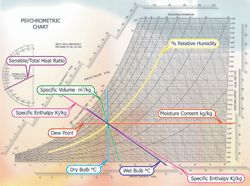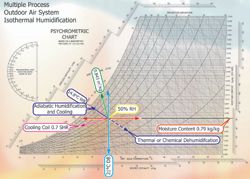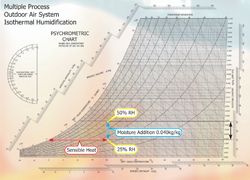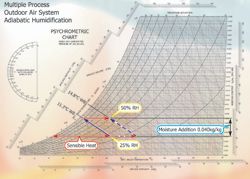Mike Creamer, author of Masterclass.
Furniture, for example, would show the typical results of being in an atmosphere where the humidity has gone from the extremes of damp to extremes of dry. Panels could split and joints break. Interestingly, the joints of most items of wooden furniture are more susceptible to damage as the glue used to fix them is likely to be hygroscopic in its own right and more prone to failure than the actual material of construction.
Comfort
In a dry atmosphere moisture migrates from the body through the nose, eyes, mouth and skin. Moisture migrating from the skin causes adiabatic cooling which will reduce the comfort of room occupants.
At 21ºC, with low humidity, moisture migrates from the skin making a room occupant feel cool. Raising the humidity level would reduce the ability of the moisture to migrate from the skin and the occupant would feel warmer.
The normal reaction, to combat the cooling effect, would be to increase the temperature of the space by one, two or three degrees. The amount of power required to produce the temperature rise can be greater than the power required bringing the humidity up to a reasonable level.

Fig 1: psychrometric chart
There have been instances where the temperature in a working environment has been reduced to nominally 19ºC and the humidity increased to 60 per cent. The comfort level was considered acceptable and the power saving substantial.
Health
Volvic, the mineral water supplier produced a report in 1999, which suggests that an office with a humidity level of 25 per cent would be as dry as the Sahara Desert.
Although it is acknowledged that low humidity is more uncomfortable than unhealthy, airborne bacteria can travel further and faster through a dry atmosphere than through a humid atmosphere. This may increase the possibility of contamination, in fact an ASHRAE report of 1979 states that 'dryness causes cracking of nasal tissues which can give inhaled germs direct access to the blood-stream'.
Contact lenses
Contact lens wearers, particularly of the hard and gas permeable type, are often the first people to complain of a dry atmosphere. The lens sits on the eye on a film of moisture. Should this film dry out then the lens feels very coarse, little more than a piece of grit, which could cause permanent damage to the eye and result in the wearer having to wear the spectacles that they were trying to avoid in the first place.
Static electricity
Below 35 per centRH, static power will build-up in an object, which will discharge to earth through anything that comes into contact with it, this is normally the human body.

Fig 2: isothermal humidification
Walking over a nylon carpet, wearing man-made soled shoes could generate a static charge of 35,000 volts in a dry atmosphere. Raising the humidity would reduce the discharge to about 1,500 volts, less than 5 per cent. Raising the humidity level above 35 per cent allows all surfaces to become covered in a microscopic film of moisture that dissipates the static charge harmlessly to earth.
Psychrometric process
The psychrometric process of humidification should consider adiabatic systems, eg sprays, ultrasonic, wetted media and spinning disc, as well as either atmospheric or pressurised steam isothermal systems. Isothermal systems can be either locally or centrally generated and powered by electricity or gas.
Main components of the psychrometric chart
The dry bulb temperature, shown in degrees centigrade, runs along the bottom horizontal axis. The vertical axis, to the right is the moisture content of air, expressed as kg of moisture per kg of air. There are three sets of diagonal lines running from top left to bottom right. The first is the wet bulb temperatures and is represented at the 100 per cent saturation curve. The second is the specific volume, measured in m3/kg of air, again represented on the 100 per cent saturation curve but dropping more steeply than the wet bulb.

Fig 3: isothermal humidification
The third is the specific enthalpy, kJ/kg of dry air. Represented by the two outer scales of the chart. The curved lines running top right to bottom left represents the percentage of moisture in suspension relative to saturation. This is expressed as per cent relative humidity, ( per centRH). A further term that is used in relation to the 100 per cent saturation line is dew point. This is a specific point within a process whereby condensation or wetting out will occur.
The humidification process revolves around wet and dry bulb temperatures, moisture content, relative humidity, specific volume and the dew point. There will be a further Masterclass that goes deeper into the psychrometric process but for this overview we need only understand the fundamentals.
Air: single process functions
Let us take a specific point within the psychrometric chart that represents an average space condition. 21ºC dry bulb (DB), 14.8ºC wet bulb (WB), 50 per cent relative humidity (RH), 0.0079kg/kg moisture content (MC), 0.843m3/kg specific volume (SV). Applying sensible heat follows the horizontal MC line to the right effectively increasing the dry bulb temperature; decreasing the relative humidity but maintaining a constant moisture content.
Dehumidification theoretically will reduce the moisture content and relative humidity whilst maintaining the dry bulb temperature. In practice this process will either heat or cool the air dependant on the type of system adopted. Diagonal lines will represent these processes to the right bottom, heating, or to the left bottom, cooling.
Sensible cooling reduces dry bulb temperature and follows the horizontal moisture content line to the left, effectively maintaining the moisture content but reducing the wet and dry bulb temperatures and increasing the RH.
Humidification can follow two paths dependant on the process adopted.
Adiabatic process follows the wet bulb line up towards the 100 per cent saturation curve, ultimately arriving at the dew point. This process will reduce the dry bulb temperature whilst increasing the moisture content and relative humidity. This can be a very useful process for reducing energy in net cooling applications.
Isothermal process travels, to all intents and purposes, up the dry bulb line. This has the effect of increasing the moisture content and RH with very little increase in the dry bulb temperature - another useful process for adding moisture without increasing the cooling load
Multiple process outdoor air system: isothermal humidification

Fig 4: adiabatic humidification
This is an example of isothermal humidification to a full ambient-air system. Taking outdoor air at 0ºC DB/0ºC WB (saturated) and increasing its temperature to 21ºC DB/10.8ºC WB, does not change the moisture content but would reduce the RH to approximately 24 per cent. The addition of 0.0040 kg of moisture per kg of air (0.0079 - 0.0039) would be required to increase the RH from 24 to 50 per cent. During the addition of moisture there would be very little increase or decrease of dry bulb temperature.
Multiple process outdoor-air system: adiabatic humidification
The adiabatic humidification process, starting from the same 0ºC DB/0ºC WB, sensible heated is added to increase the temperature to 21ºC DB. Applying the cold water moisture system would follow the wet bulb line up to 95 per cent RH with a dry bulb temperature reduction to 11.3ºC. We have added the same amount of moisture as with the Isothermal system, 0.004kg/kg of air. More sensible heat must be added to bring the air to the supply condition required, ie 21ºC DB/50 per cent RH.
In practise the condition before the application of the second sensible heat, 95 per cent RH is very close to the dew point and it is difficult to control at this high level, therefore another way would be to overheat the ambient air to 31ºC DB/14.8ºC WB. Adding moisture, following the wet bulb line to the supply air condition corresponding to 50 per cent RH, the same amount of heat has been applied but at one point rather than two. This has the effect of reducing the capital cost, as it will be a single large heater rather than two smaller ones. There is also a better chance of controlling the system without wetting out.
Psychrometric load calculations
Design criteria (for each example, the same design criteria are used):
Outdoor air volume: 1m3/sec
Outdoor: 0ºC DB/100 per centRH/0.0038kg/kg MC
Specific volume: 0.832 m3/kg
Indoor: 21ºC DB/50 per centRH/0.0079kg/kg MC
Moisture differential: 0.0079-0.0039 = 0.0041 kg/kg
It is worth noting that in any calculation only the outdoor-air intake would be considered, therefore this calculation would remain true if the total air volume was 10 m3/sec and the outdoor air proportion was 10 per cent.

The calculation uses the air volume at (1m3/sec), multiplied by the moisture differential (0.0041kg/kg) and the number of seconds in an hour (3600), then divided by the specific volume (0.832m3/kg).
The resultant value of 17.74kg/hr can be used as a useful yardstick figure for the amount of moisture required for every 1m3/sec of outdoor-air coming into a system.
It is worth pointing out the specific volume (0.832m3/kg) used in this calculation is derived as the mean difference of the specific volumes at the start and finish of the process.
This energy balance is a generalisation for a typical air conditioning application using a minimum quantity of outdoor air.
There is little difference in the total power requirements of the two systems so any differentiation will be within the type of energy used to heat either the water for steam or air for reheat in the adiabatic process.
With thanks to Mike Creamer of Business Edge who revisits his Masterclass series of articles, updating and adding to the information which proved so useful to readers when the series was first published over ten years ago. In this reincarnation, the series will cover both air conditioning and refrigeration and serve as an on-going source of technical reference for experienced personnel as well as providing a solid educational grounding for newcomers to our industry.